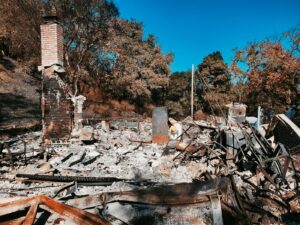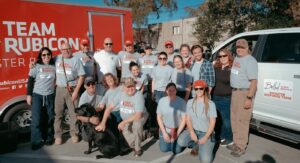Jasper went first, then Piper. The border collies darted back and forth across the bare, scorched foundation of what was once a family home, hopping onto piles of twisted metal or remnants of walls that refused to topple all the way to the ground. They were oblivious to the spectacular autumn sunshine and the mountaintop view that inspired three generations of the Teter family to live and vacation here, and to the acrid smell of charcoal ash and the charred trunks of trees standing ghostly watch, reminders of nature’s fury that swept through and destroyed this mountain idyll. Instead, they focused on their mission, and when they found what they were looking for—human ashes—they sat.

The remains of the Teter house.
No one was home that Sunday night in early November 2019 when the inferno of the Kincade Fire ripped through this hillside overlooking the Alexander Valley in Sonoma County, California, destroying the home Joan Teter and her husband built in the 1970s, along with an artist studio and two guest cottages. But the house held the cremated remains—or cremains—of five family members, including Joan’s husband, all separated from their urns and scattered by the fire. Locating these remains was the first order of business in cleaning up the site.
Jasper, Piper and their handlers are members of the Institute of Canine Forensics. The Teter homesite was their first collaboration with Team Rubicon and its volunteer group of military veterans, experienced first responders, and “kick-ass civilians” who participate in disaster relief efforts. The three-day effort, dubbed “Operation Autumn Winds,” was also Team Rubicon’s first joint effort with Bethel Global Response, a disaster relief arm of Bethel Ministries, based in Redding, California.
Joining forces with other groups seems like a natural course, but is actually not that common, said John Saguto, a retired pararescue jumper with the U.S. Special Forces. Saguto worked a decade in disaster relief with the American Red Cross before joining Team Rubicon in 2012 after seeing the group’s efforts to help victims of Super Storm Sandy in New Jersey. He himself became a client when the Trinity Fire of October 2017 destroyed his motorcycle repair shop in Sonoma, California.
“I’m tired of competition to help people,” Saguto said. “Why not work together to help people recover from the worst day of their lives?” He said Team Rubicon members sifting through rubble had found personal treasures “as small as a porcelain pig” to “vaults of diamonds.”

Greyshirts in Sonoma.
The 31 members participating in Operation Autumn Winds bivouacked in a veterans building in Cloverdale, just a few miles from where the Kincade Fire did its worst. The meeting hall was filled with cots and other gear, while an adjacent office served as a command post. From here, they would spend a long weekend traipsing out to 15 sites to help survivors recover belongings from homes destroyed in the fire.
Back at the Teter homesite, David Henry, an Air Force veteran from nearby Santa Rosa, watched Jasper and Piper work while he waited to participate in his first Team Rubicon operation.
“A good friend introduced me to the outfit,” Henry said, explaining that some of his neighbors lost their homes in the Tubbs Fire that devastated Santa Rosa in October 2017. “Because of the Tubbs Fire, I’ve learned the best way to overcome any hardship is to get involved. It helps the healing process.”
Caroline Upton is not just a Team Rubicon volunteer: She also works full time in disaster response, with an urban search-and-rescue team for the Federal Emergency Management Agency. She first saw Team Rubicon in action following Hurricane Harvey in Houston, and has participated in several operations since using her weekends and annual leave.

The forensic team isolates cremains.
Like the other volunteers, Upton was decked out in a Tyvek hazmat suit, with safety goggles, a double set of gloves and a hardhat, an N-95 mask at hand to guard against hazardous dust. She stood among Teter family items that somehow survived the fire: a wooden table and picnic bench, metal children’s seats, a gas grill and, amazingly, a propane tank.
“At some point, it will be our turn,” she said, watching the dogs work the site.
After the dogs had pinpointed the location of the human cremains, the Team Rubicon members quickly set to work. A forensic archeologist gave instructions on how to identify and isolate the cremains. Some team members began pulling items from the rubble, laying them on a tarp.
Joel Puliatti, Joan Teter’s son-in-law, asked the searchers to salvage anything they could amid the rubble—artifacts, ceramics, metal—for his wife, Olivia Teter. “My wife is a structural artist, so anything you can save, she’d like to make a statue,” he said, his voice trailing off.
“It’s a relief,” he said after the dogs located his relatives’ cremains and the recovery work began in earnest. “But as my wife said, they are part of the property now.”



